Dualit Pour Over Kettle review: a stylish gooseneck kettle for making teas & coffees
This classic, retro-styled Dualit kettle is just the ticket for coffee and tea connoisseurs

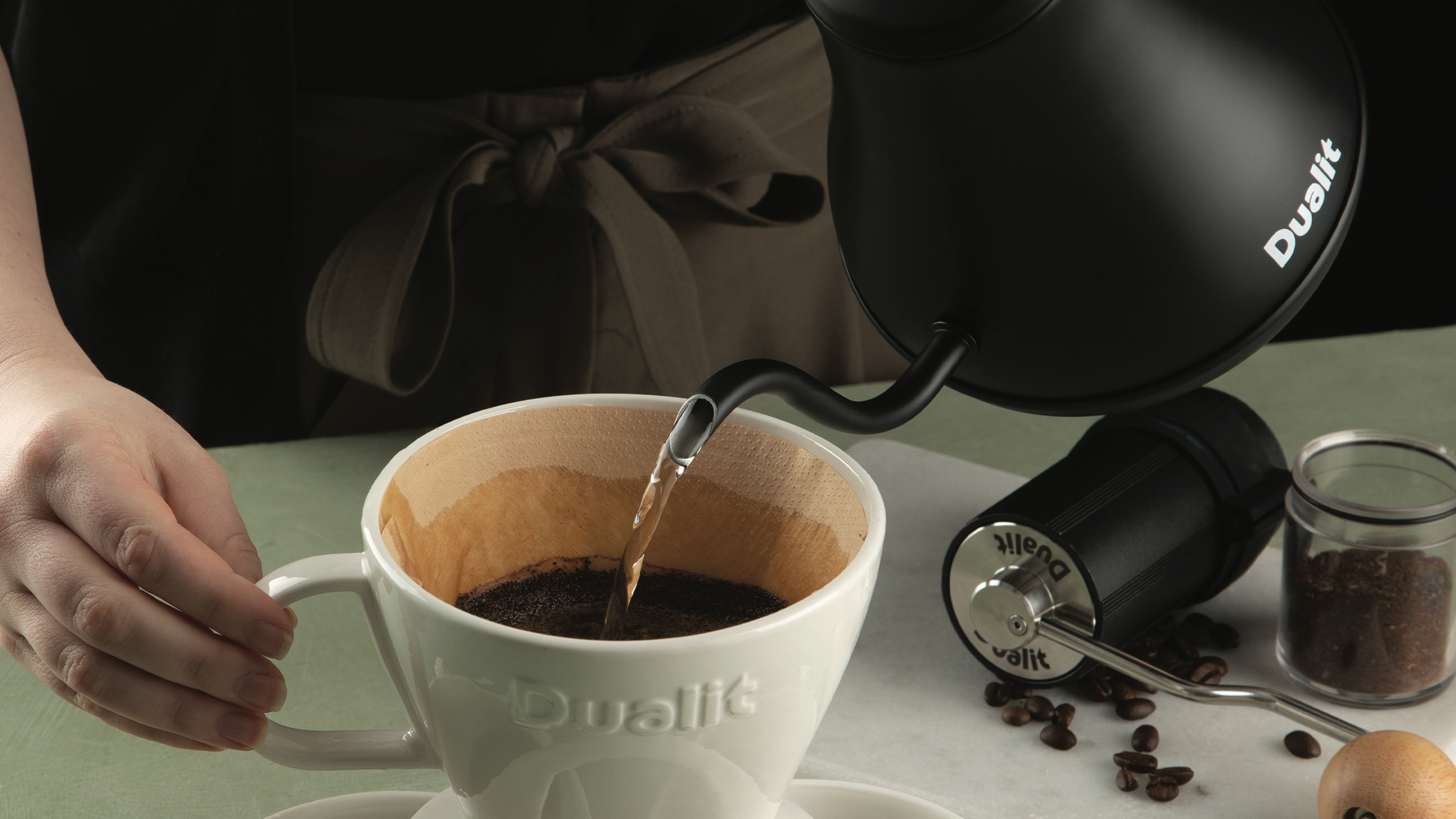
Looking for a snazzy variable temperature kettle that’s designed specifically for pouring over coffee and making tea of every variety? The retro-styled Dualit Pour Over is the kettle for you. With it’s easy-to-use digital controls, slim gooseneck spout and wide temperature range from 38˚C to 100˚C, this is the perfect kettle for all your hot beverage needs.
-
+
Great retro styling
-
+
Slim gooseneck for delicate pouring
-
+
Wide temperature range
-
+
Easy interface
-
-
Small 800ml capacity
-
-
Takes a long time to boil at full capacity
-
-
Slow to pour
Why you can trust T3

Welcome to T3’s review of the Dualit Pour Over Kettle, a multi-temperature kettle that’s perfect for coffee lovers and tea aficionados.
Given that the best kettle is such a kitchen essential, whether it’s for making hot beverages or filling a saucepan with boiling water in readiness for the best induction hob, we thought we’d go a little off-piste in this instance and have a good close look at a kettle that's specifically designed for making pour-over coffee and tea of every variety.
So, without further ado, let’s put the kettle on.
Dualit Pour Over Kettle review: price & availability
If you live in the UK, you can purchase the Dualit Pour Over kettle direct from Dualit for £89.99, or head over to John Lewis & Partners and Amazon, where it’s selling for exactly the same price.
Despite an extensive search using Tunnel Bear VPN, we could find no evidence of this kettle being sold in the USA or Australia. However, there are plenty of similarly-styled gooseneck options available.
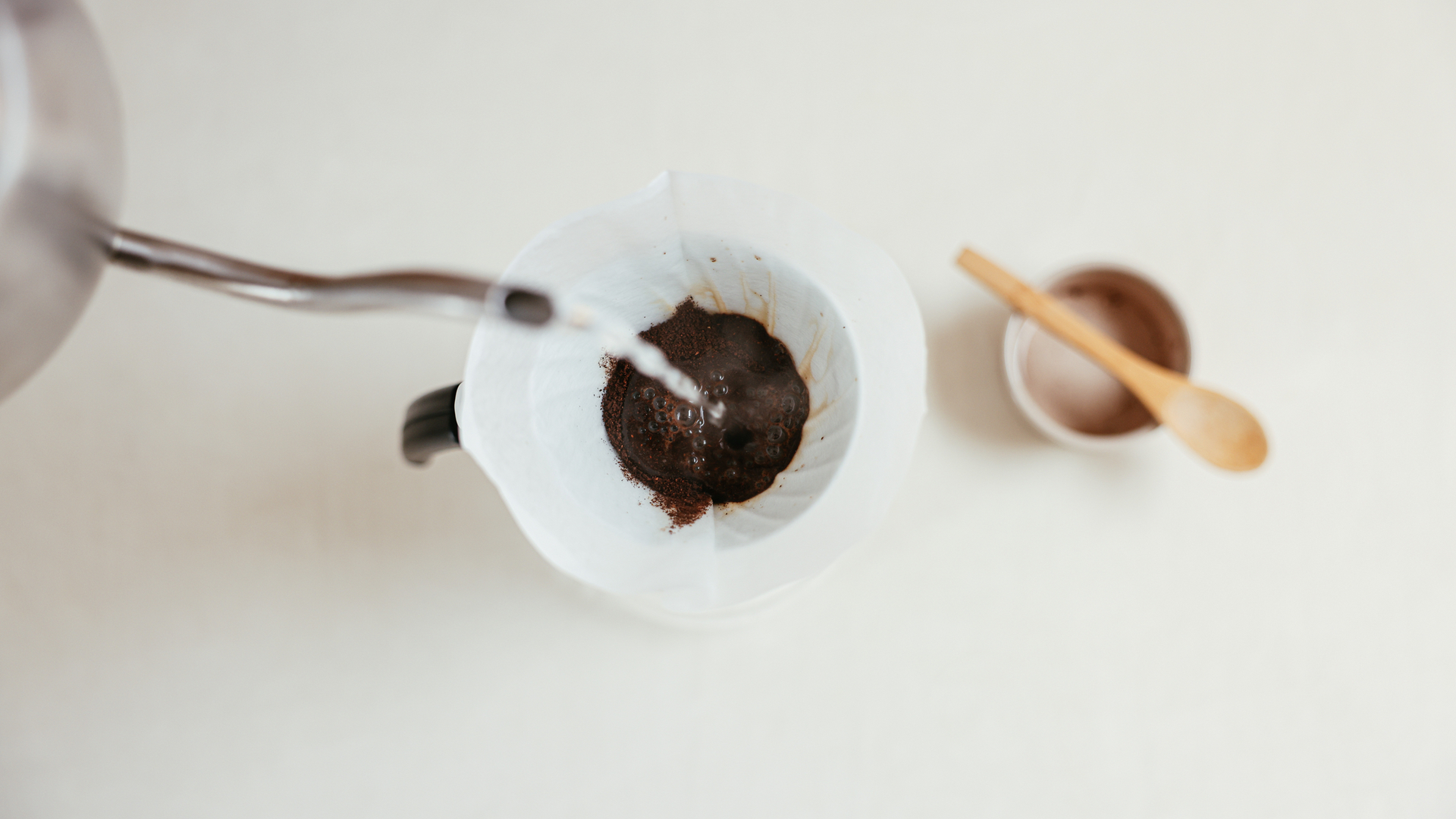
Dualit Pour Over Kettle review: why would I need a gooseneck kettle?
Gooseneck kettles are all the rage with discerning coffee and tea lovers. We’re talking about the kind of aficionados that want to get the best out of their teas and coffees without pummeling the leaves and grounds into submission. For instance, making pour-over coffee isn’t just about chucking in a cup or more of hot water with total abandon. It’s a s-l-o-w drawn-out process involving a thin stream of hot water caressing the grounds in a circular motion until the coffee is completely suffused and the water is left to slowly permeate the grounds so that the resulting cup of coffee is at its very best. The same technique applies to teas.
Granted, this may sound like a load of mumbo jumbo but the simple fact is that whether you are a cultured beverage maker or not, the act of pouring water through a thin spout is, above all, rather gratifying, even therapeutic in a strange kind of way.
Get all the latest news, reviews, deals and buying guides on gorgeous tech, home and active products from the T3 experts
What are the best brewing temperatures for teas & coffees?
Contrary to what most of us do – that is boil the kettle and immediately pour in the water – most teas and all coffees taste best when brewed using water that’s below boiling point and, in some case, well below boiling point. In fact, according to Tetley brand development manager Peter Haigh, black tea is the only variety to benefit from water at boiling - or near boiling point. The rest are best made using a temperature between 70˚C and 98˚C.
Green tea is a prime candidate for low water temperatures of between 70˚ and 80˚ while delicate Oolong tea is best at around 88˚. South African Rooibos is happiest at around 98˚ or lower, while some experts say that 100˚C is perfectly fine, too. Most herbal teas should be made using water at around 95˚C.
When it comes to coffee, temperatures can vary depending on the type of coffee and method of extraction. The golden rule is to never go over 98˚C in order to maximise the coffee’s pleasant aromas while minimising any unpleasant bitterness. When it comes to the pour-over variety, everyone accepts that the water temperature should rarely be over 96˚C while some say that a temperature as low as 93˚C is the best target figure.
Just bear in mind that water boils at different temperatures depending on your altitude. So, if you live at 3,500m, you can safely pour that freshly boiled water into your coffee because it will effectively only be at around 95˚C. Now you know!
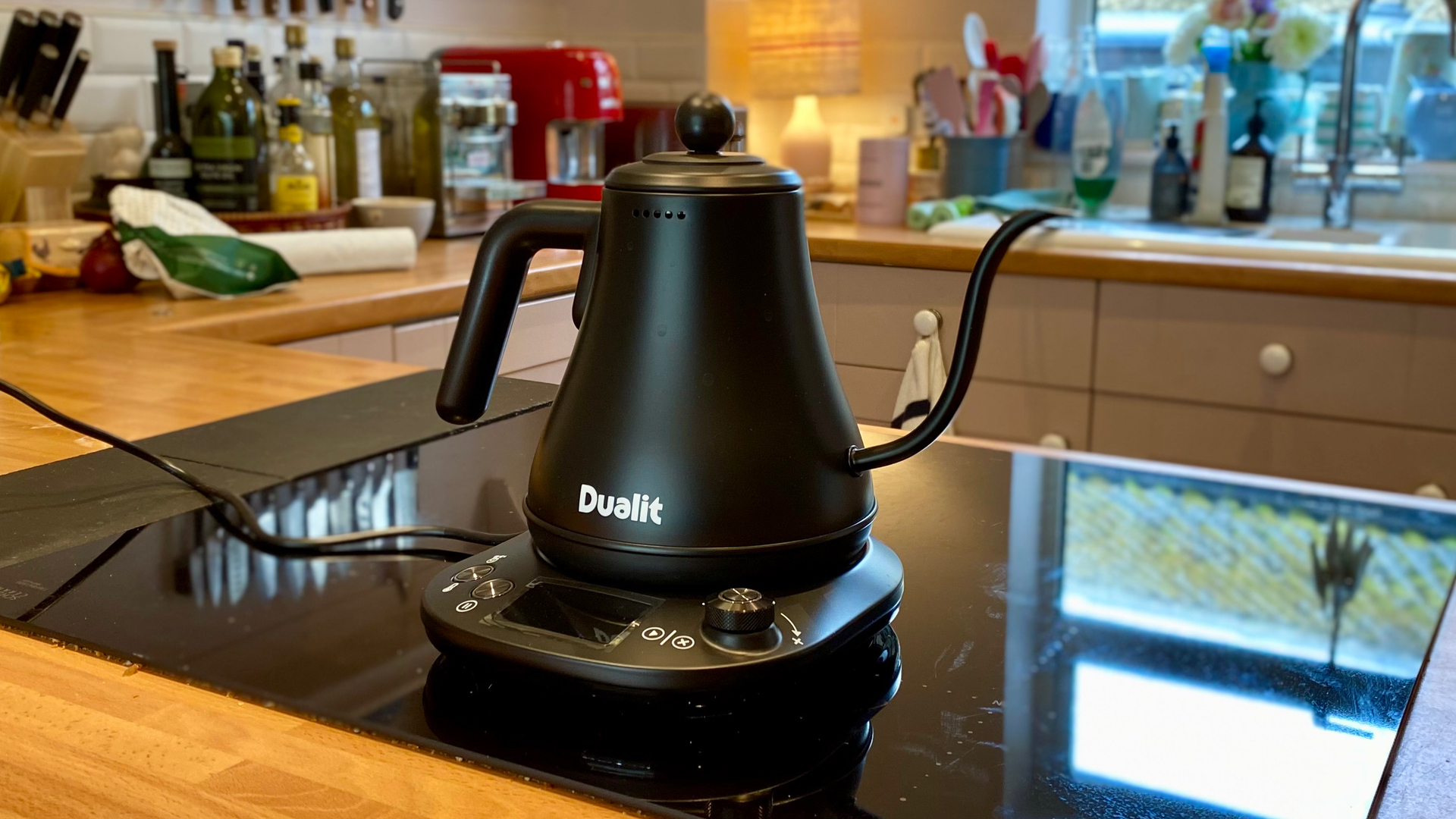
The Dualit Pour Over kettle in the writer's kitchen
Dualit Pour Over Kettle review: design
If you’ve never tried a gooseneck kettle, you’re in for a surprise because a gooseneck kettle makes the act of pouring hot water a tactile pleasure that's hard to replicate with a standard spout model.
High-end brand Dualit produces a number of fine kettles, some of which you can read about in our best kettle guide, but this 800ml model is the one to opt for if you want access to a wide band of water temperatures along with a gooseneck-shaped spout for delicate pouring.
The Dualit Pour Over is cast from stainless steel and coated in an attractive matt black finish. Its retro styling is just like the kettles of old that our great-grandparents used on their wood burners. The slim dripless gooseneck spout is a thing of beauty but you wouldn’t want to drop this kettle or bang it hard against a porcelain sink because the spout could quite literally snap off. Whatever, in the pantheon of kitchen kettles, the Dualit Pour Over is a stunner whichever way you look at it. It’s lovely to use, too, partly because the handle is so perfectly designed for controlled pouring.
The Dualit’s black control base is unobtrusive and can be used at any angle – par for the course with the vast majority of kettles. However, unlike most kettles, this model provides the wherewithal to select a wide range of water temperatures which makes it the perfect kettle for making tea and coffee.
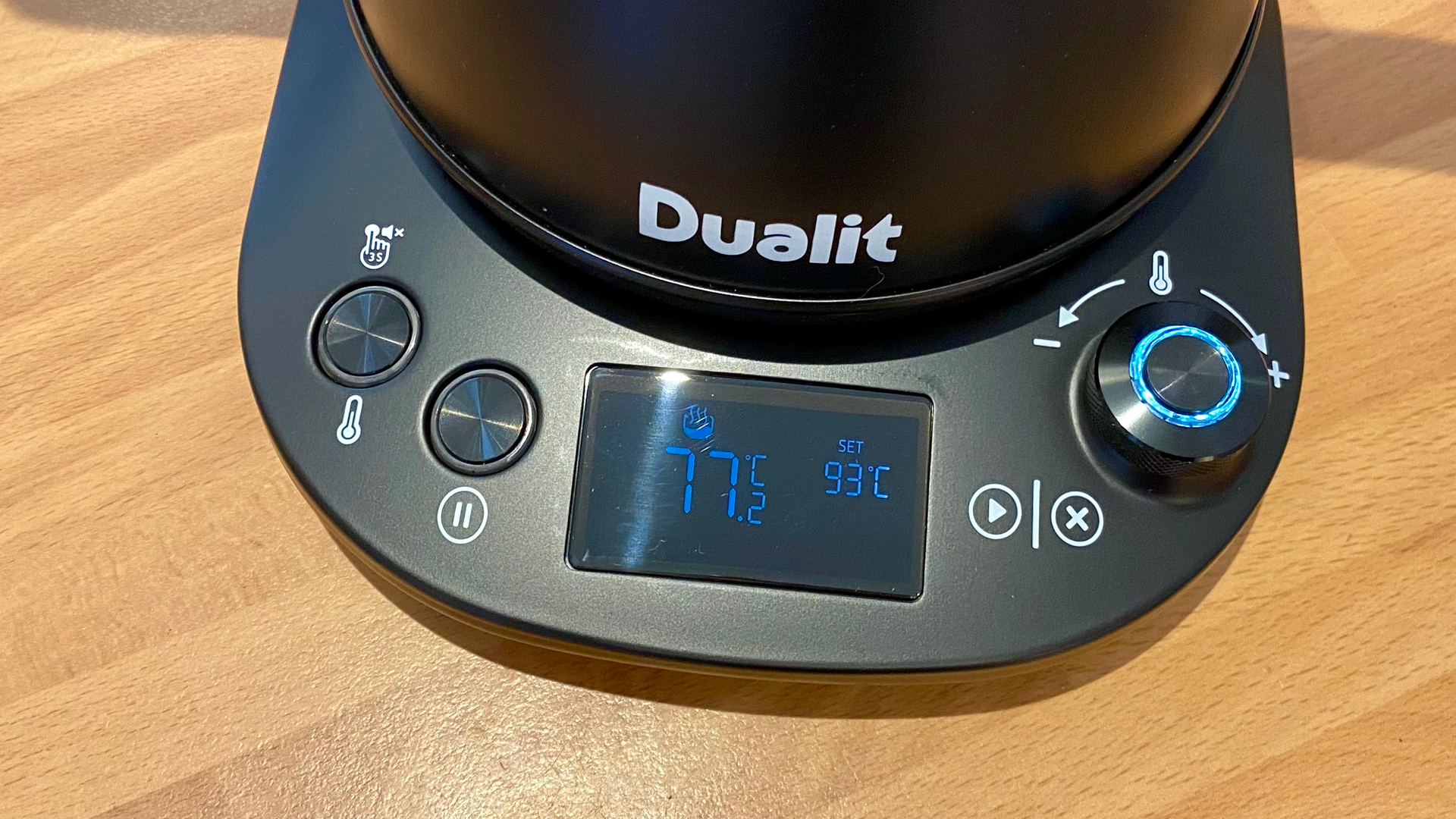
The Dualit Pour Over Kettle comes with a fabulously easy control interface
Dualit Pour Over Kettle review: features
The first thing I should mention is that this kettle only has a capacity of 800ml which is about 900ml less than the average. This may make it an unsuitable choice if you use a kettle as much to boil large amounts of water for saucepan cooking as you do for making teas and coffees. Also, the very nature of the ultra slim neck means that it takes much longer to empty the contents than other kettles with much wider spouts. The similarly-styled KitchenAid Gooseneck gets around this by having a variable flow sheath that allows three levels of water volume but this one has just a simple exit hole in the bottom where the spout is affixed.
As any tea or coffee connoisseur will vouch, both beverages are best made at temperatures below boiling point so that the leaves and grounds aren’t scalded and possibly spoiled. Well, this kettle comes with a range of temperatures from an astonishingly low 38˚C to 100˚C boiling point. And what’s more, the temperatures go up and down in 1˚ increments.
To access the kettle’s functions, head to the base and you’ll find three sets of controls: a button that lets you select between Fahrenheit and Celsius and mute the key tones; a pause button which holds the set temperature for 5 minutes, even if you remove the kettle from the power base and, best of all, a tactile push dial for selecting your preferred water temperature.
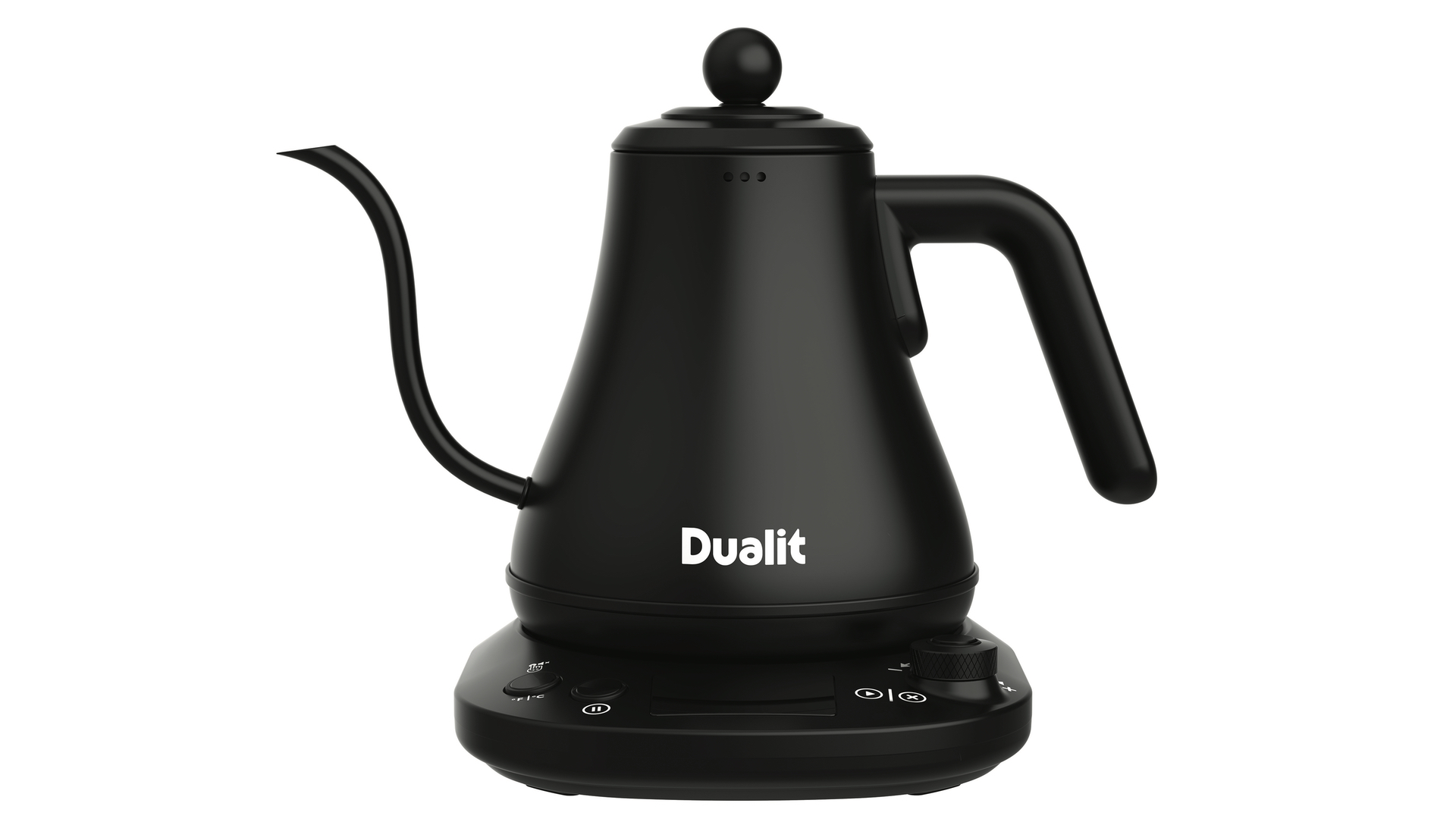
Dualit Pour Over Kettle review: performance
First and foremost, this kettle has been a joy to use. I love the fact I can change temperature at will simply by turning a dial and pressing it in. I also rate the design of the handle and the general balance of the kettle when pouring – and this kettle pours beautifully with a slim 4mm wide stream of water that caresses tea leaves and coffee grounds instead simply piling in and agitating the leaves or grounds to within an inch of their little lives.
My first test was to boil a standard teacup’s worth of water and it took just 1 minute and 25 seconds. What’s more, I could watch the temperature rise in tenths of a degree. When boiled, the base emitted a very faint electronic beep that you will likely never hear.
Since there are no markings on the kettle, I filled it to a safe area and the nearly-full load took a not very impressive 4 minutes and 39 seconds to boil from a room temperature of 18˚C – a whole minute more than the 1.7-litre Sage Soft Top Pure kettle I reviewed recently.
While over four minutes is an extremely long time for a full kettle to boil – let alone a small one – I don’t think this would be too much of an issue unless filling a teapot or a large French press. However, it’s worth noting if you’re an impatient type.
Dualit Pour Over Kettle review: verdict
I wouldn’t say that the Dualit Pour Over should be the only kettle in the household because it’s not big enough and it takes a long time to pour a full pot’s worth. But for tea and coffee making purposes, it’s a fabulous addition to one’s kitchen armoury.
Derek (aka Delbert, Delvis, Delphinium, Delboy etc) specialises in home and outdoor wares, from coffee machines, white appliances and vacs to drones, garden gear and BBQs. He has been writing for more years than anyone can remember, starting at the legendary Time Out magazine – the original, London version – on a typewriter! He now writes for T3 between playing drums with his bandmates in Red Box (redboxmusic).
